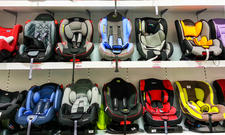The TÜV publishes statistics every year about the Defects of the vehicles examined in the past year. We show the winners and losers in the picture gallery! >> More about TÜV
Photo: BauerStock / AUTO ZEITUNG TÜV Defect Report 2020
Overall winner and winner of the SUVs is the Mercedes GLC with the fewest significant defects.
Photo: Mercedes TÜV Defect Report 2020
The Porsche 911, which otherwise holds the top positions in the age groups between four and eleven years, and the.
Photo: Porsche TÜV Defect Report 2020
. Mercedes SLK / SLC second place in the two to three year olds.
Photo: Mercedes TÜV Defect Report 2020
Fourth place (B class) and.
Photo: Mercedes TÜV Defect Report 2020
. five (A-Class) go to Mercedes.
Photo: Mercedes TÜV Defect Report 2020
The Swabian C-Class has to take sixth place with the.
Photo: Mercedes TÜV Defect Report 2020
. Share CX-3 from the Japanese manufacturer Mazda.
Photo: Mazda TÜV Defect Report 2020
In the two to three year old small cars, the Audi A1 also has a German car in front while.
Photo: Audi TÜV Defect Report 2020
. the Italian Fiat Punto brings up the rear.
Photo: Fiat TÜV Defect Report 2020
The Opel Adam and.
Photo: Opel TÜV Defect Report 2020
. the Ford Ka is the last here.
Photo: Ford TÜV Defect Report 2020
The Dacia Logan (2nd generation) also performs poorly, with a deficiency rate of 13.6 percent among the two to three year olds.
Photo: Dacia TÜV Defect Report 2020
In the eight- to nine-year-old cars, the Audi TT and.
Photo: Audi TÜV Defect Report 2020
. and the BMW X1 in second and third place.
The TÜV Defect Report 2020 is here and the results are largely convincing. The number of vehicles without defects in the main inspection (HU) is again slight gone up. These are the winners and losers of the HU!
As every year, the TÜV Defect Report 2020 shows the winners and losers of the main inspection. The evaluation is based on the results of around nine million vehicles examined, which were presented to the HU between July 2018 and June 2019. The TÜV came to the conclusion that around one in five cars (21.5%) failed the TÜV due to defects at the HU. According to the report, the rate of significant deficiencies rose slightly by 0.3 percentage points compared to the same period last year. Almost every tenth car drives up with minor defects (9.7%). That is three percentage points fewer. Defects at the HU often led to defects in the lighting, oil on the engine or transmission, as well as worn brake discs. Vehicle owners have to show such cars again in order to get the inspection sticker. On a positive note, the number of cars without defects rose by 1.1 percent to 68.8 percent. In the TÜV Defect Report 2020, the test association also found that older vehicles rattle through the HU more often. The defect rate correlates with the age of the vehicle: While only 5.8 percent of the two to three year old cars have significant defects, 16.4 percent of the six to seven year old cars fail. And if ten to eleven years old cars drive up, more than one in four (28.2%) don’t get the badge the first time. The cars on German roads are getting older: At present, the average age is 9.5 years. Due to better rust prevention, cars keep going longer and would hardly be pulled out of traffic due to corrosion. However, the TÜV association advises to regularly check the technology of older vehicles for wear and to replace the corresponding parts in good time. More on the topic: HU costs vary
repair & maintenance

The TÜV checklist (video):
These are the winners & Losers of the TÜV Defect Report 2020
The German manufacturers are among the winners of the TÜV Defect Report 2020. Audi, Mercedes and Porsche in particular performed particularly well at the HU. Overall winner and winner of the SUV is the Mercedes GLC with the fewest significant defects (2.17%). The second place among the two to three year olds is shared by the Porsche 911 and the Mercedes SLK / SLC (each 2.20%). Also the Fourth (B-Class) and fifth (A-Class) go to Mercedes. The Swabian C-Class had to share sixth place with the Mazda CX-3. Even in the two to three year old small cars, the Audi A1 (3.1%) is a German car. The Italian Fiat points (10.8%) comes in last. The Opel Adam (4.0%) wins the Minis, the Ford Ka (10.7%) the last here. The Dacia Logan (2nd generation) also performed poorly, with a deficiency rate of 13.6 percent among the two to three year olds. In the eight- to nine-year-old cars, the Audi TT and BMW X1 took second and third places behind the Porsche 911. The classic sports car occupies the top positions in the age groups between four and eleven years and only has to be relegated to second place for the two to three year olds.
News

RELATED ITEMS
-

The children’s room – retreat for children, living idea
A child’s retreat should keep pace with its growth. Because where people still romp today, chill out tomorrow. No room in the…
-

After a poem by Heinrich A. H. von Fallersleben and an English melody from the 19th century, the song Merry Christmas was created…
-

Climate protection scientists: "Make fewer children" – focus online
Spotted an Error? Global warming is a consequence of billions of small individual decisions – and is taking an increasingly serious one…
-

Child seat test 2019: the best seats
In October ADAC and Stiftung Warentest publish the second part of their child seat test 2019. >> More about child seat test Photo:…
